Coursework 2: Managing Innovation in Business - Octopus Energy Report
VerifiedAdded on 2023/01/11
|12
|3868
|90
Report
AI Summary
This report provides a comprehensive analysis of Octopus Energy's innovation strategies within the context of the energy industry's future. It begins with an introduction highlighting the importance of innovation for organizational sustainability and competitiveness, particularly in the green energy sector. The report then delves into the future of the energy industry through a PESTLE analysis, examining political, economic, social, technological, legal, and environmental factors influencing the sector. A SWOT analysis of Octopus Energy identifies its strengths, weaknesses, opportunities, and threats, followed by an exploration of the organization's innovation requirements, including pulp energy and static compensators. The McKinsey 7S framework is applied to assess the company's strategy, structure, systems, shared values, style, staff, and skills, revealing areas for improvement. Finally, the report offers a roadmap for building future innovation capabilities for Octopus Energy, emphasizing the importance of strategic choices and the need to align internal capabilities with external market demands to achieve long-term sustainability and success in the dynamic energy landscape. The report is a coursework assignment that highlights the importance of innovation in the energy sector.
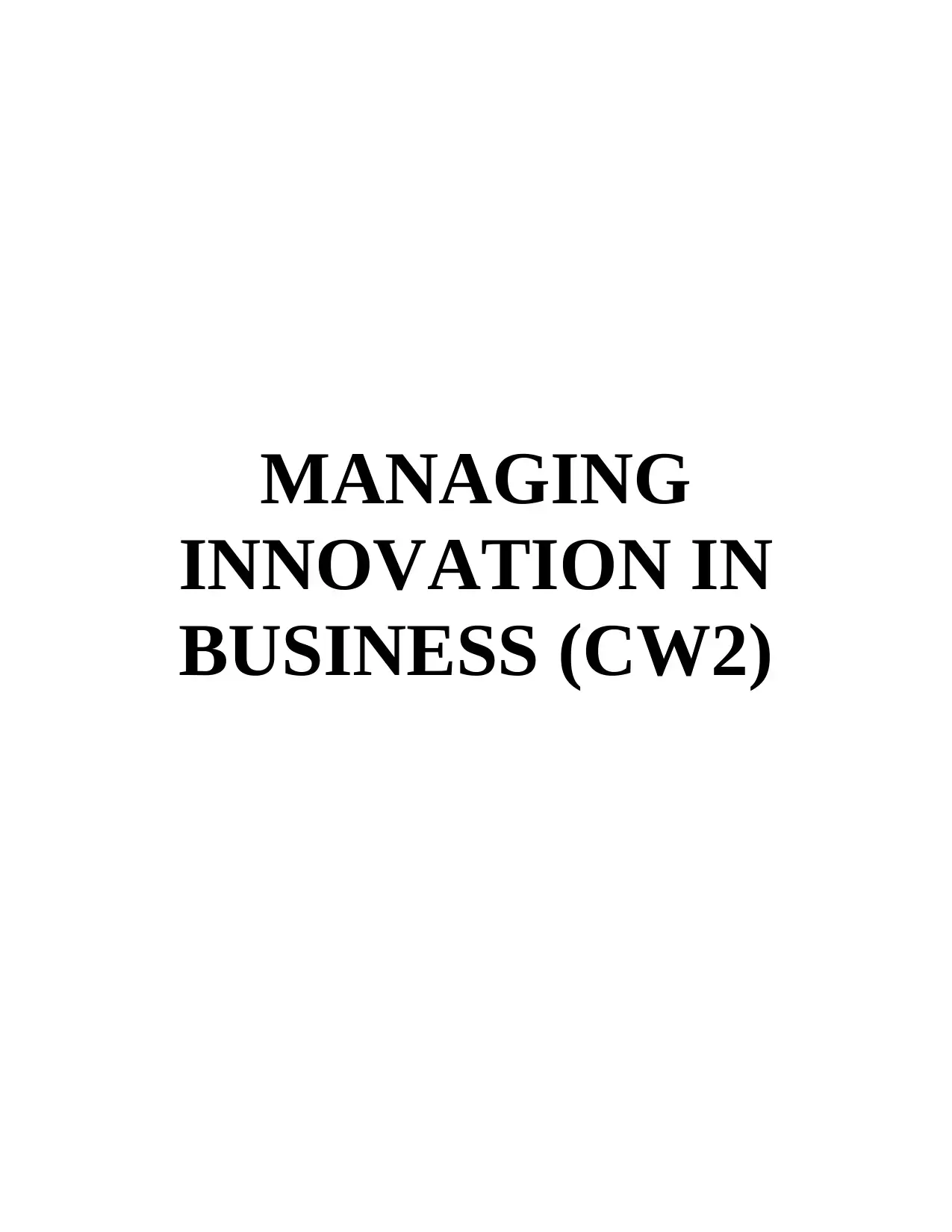
MANAGING
INNOVATION IN
BUSINESS (CW2)
INNOVATION IN
BUSINESS (CW2)
Paraphrase This Document
Need a fresh take? Get an instant paraphrase of this document with our AI Paraphraser
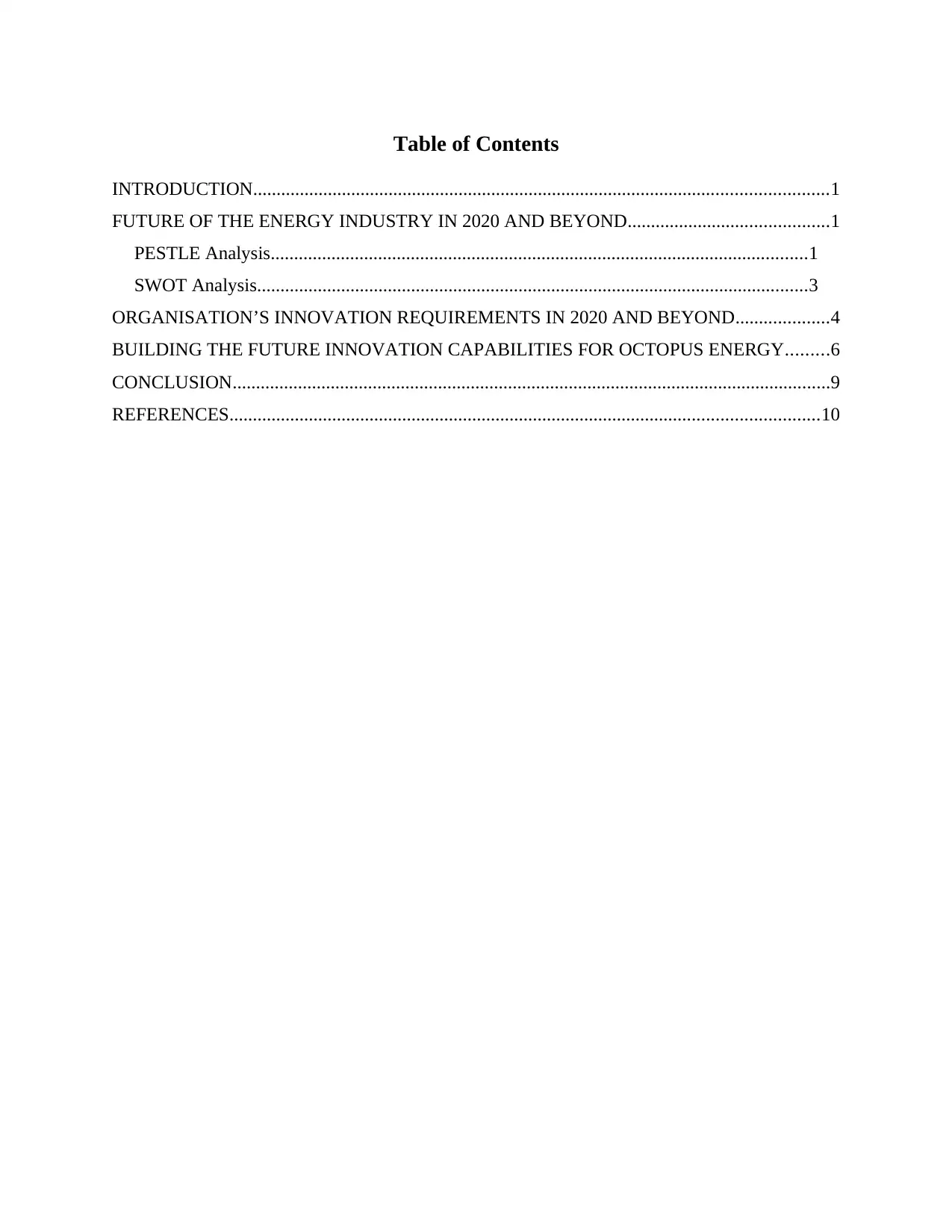
Table of Contents
INTRODUCTION...........................................................................................................................1
FUTURE OF THE ENERGY INDUSTRY IN 2020 AND BEYOND...........................................1
PESTLE Analysis...................................................................................................................1
SWOT Analysis......................................................................................................................3
ORGANISATION’S INNOVATION REQUIREMENTS IN 2020 AND BEYOND....................4
BUILDING THE FUTURE INNOVATION CAPABILITIES FOR OCTOPUS ENERGY.........6
CONCLUSION................................................................................................................................9
REFERENCES..............................................................................................................................10
INTRODUCTION...........................................................................................................................1
FUTURE OF THE ENERGY INDUSTRY IN 2020 AND BEYOND...........................................1
PESTLE Analysis...................................................................................................................1
SWOT Analysis......................................................................................................................3
ORGANISATION’S INNOVATION REQUIREMENTS IN 2020 AND BEYOND....................4
BUILDING THE FUTURE INNOVATION CAPABILITIES FOR OCTOPUS ENERGY.........6
CONCLUSION................................................................................................................................9
REFERENCES..............................................................................................................................10
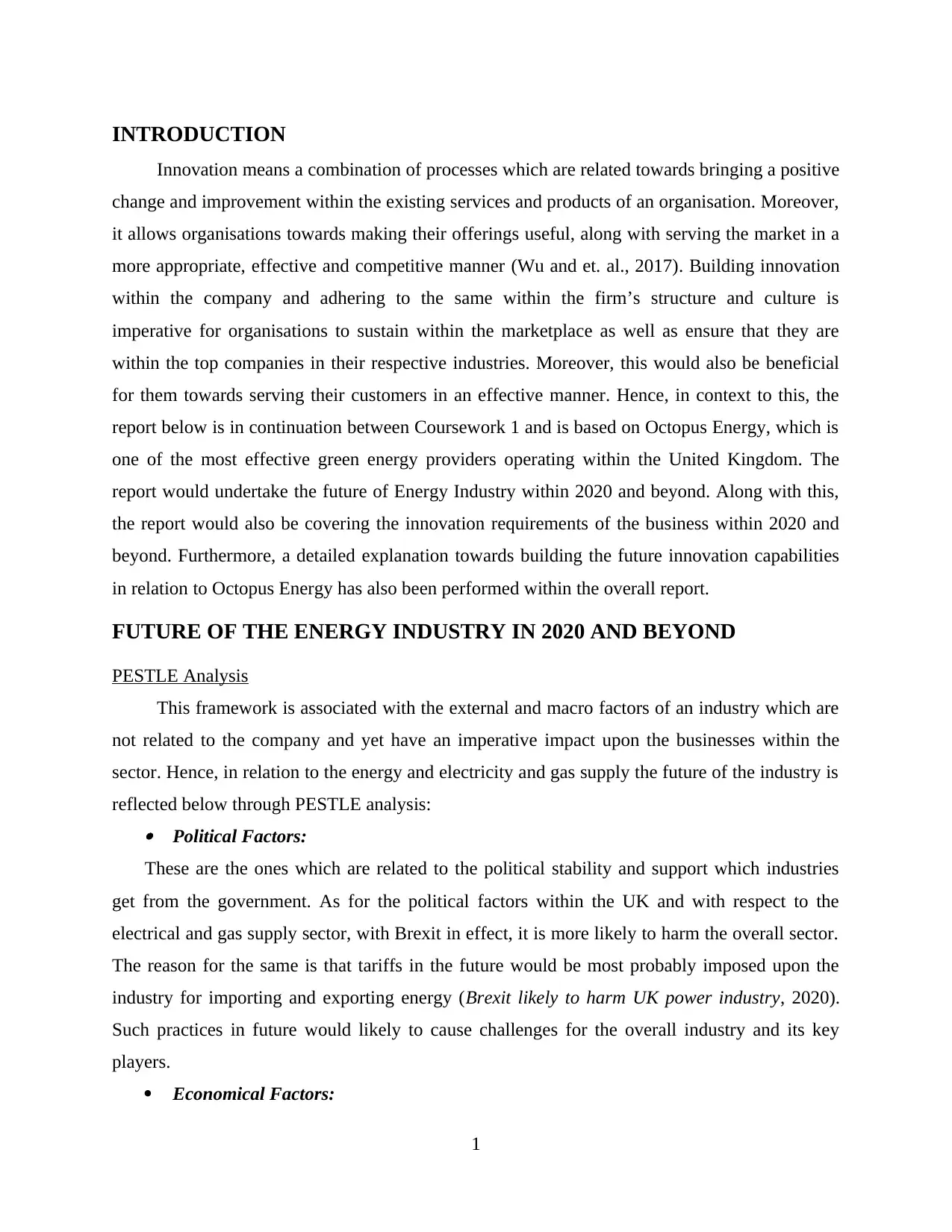
INTRODUCTION
Innovation means a combination of processes which are related towards bringing a positive
change and improvement within the existing services and products of an organisation. Moreover,
it allows organisations towards making their offerings useful, along with serving the market in a
more appropriate, effective and competitive manner (Wu and et. al., 2017). Building innovation
within the company and adhering to the same within the firm’s structure and culture is
imperative for organisations to sustain within the marketplace as well as ensure that they are
within the top companies in their respective industries. Moreover, this would also be beneficial
for them towards serving their customers in an effective manner. Hence, in context to this, the
report below is in continuation between Coursework 1 and is based on Octopus Energy, which is
one of the most effective green energy providers operating within the United Kingdom. The
report would undertake the future of Energy Industry within 2020 and beyond. Along with this,
the report would also be covering the innovation requirements of the business within 2020 and
beyond. Furthermore, a detailed explanation towards building the future innovation capabilities
in relation to Octopus Energy has also been performed within the overall report.
FUTURE OF THE ENERGY INDUSTRY IN 2020 AND BEYOND
PESTLE Analysis
This framework is associated with the external and macro factors of an industry which are
not related to the company and yet have an imperative impact upon the businesses within the
sector. Hence, in relation to the energy and electricity and gas supply the future of the industry is
reflected below through PESTLE analysis: Political Factors:
These are the ones which are related to the political stability and support which industries
get from the government. As for the political factors within the UK and with respect to the
electrical and gas supply sector, with Brexit in effect, it is more likely to harm the overall sector.
The reason for the same is that tariffs in the future would be most probably imposed upon the
industry for importing and exporting energy (Brexit likely to harm UK power industry, 2020).
Such practices in future would likely to cause challenges for the overall industry and its key
players.
Economical Factors:
1
Innovation means a combination of processes which are related towards bringing a positive
change and improvement within the existing services and products of an organisation. Moreover,
it allows organisations towards making their offerings useful, along with serving the market in a
more appropriate, effective and competitive manner (Wu and et. al., 2017). Building innovation
within the company and adhering to the same within the firm’s structure and culture is
imperative for organisations to sustain within the marketplace as well as ensure that they are
within the top companies in their respective industries. Moreover, this would also be beneficial
for them towards serving their customers in an effective manner. Hence, in context to this, the
report below is in continuation between Coursework 1 and is based on Octopus Energy, which is
one of the most effective green energy providers operating within the United Kingdom. The
report would undertake the future of Energy Industry within 2020 and beyond. Along with this,
the report would also be covering the innovation requirements of the business within 2020 and
beyond. Furthermore, a detailed explanation towards building the future innovation capabilities
in relation to Octopus Energy has also been performed within the overall report.
FUTURE OF THE ENERGY INDUSTRY IN 2020 AND BEYOND
PESTLE Analysis
This framework is associated with the external and macro factors of an industry which are
not related to the company and yet have an imperative impact upon the businesses within the
sector. Hence, in relation to the energy and electricity and gas supply the future of the industry is
reflected below through PESTLE analysis: Political Factors:
These are the ones which are related to the political stability and support which industries
get from the government. As for the political factors within the UK and with respect to the
electrical and gas supply sector, with Brexit in effect, it is more likely to harm the overall sector.
The reason for the same is that tariffs in the future would be most probably imposed upon the
industry for importing and exporting energy (Brexit likely to harm UK power industry, 2020).
Such practices in future would likely to cause challenges for the overall industry and its key
players.
Economical Factors:
1
⊘ This is a preview!⊘
Do you want full access?
Subscribe today to unlock all pages.

Trusted by 1+ million students worldwide
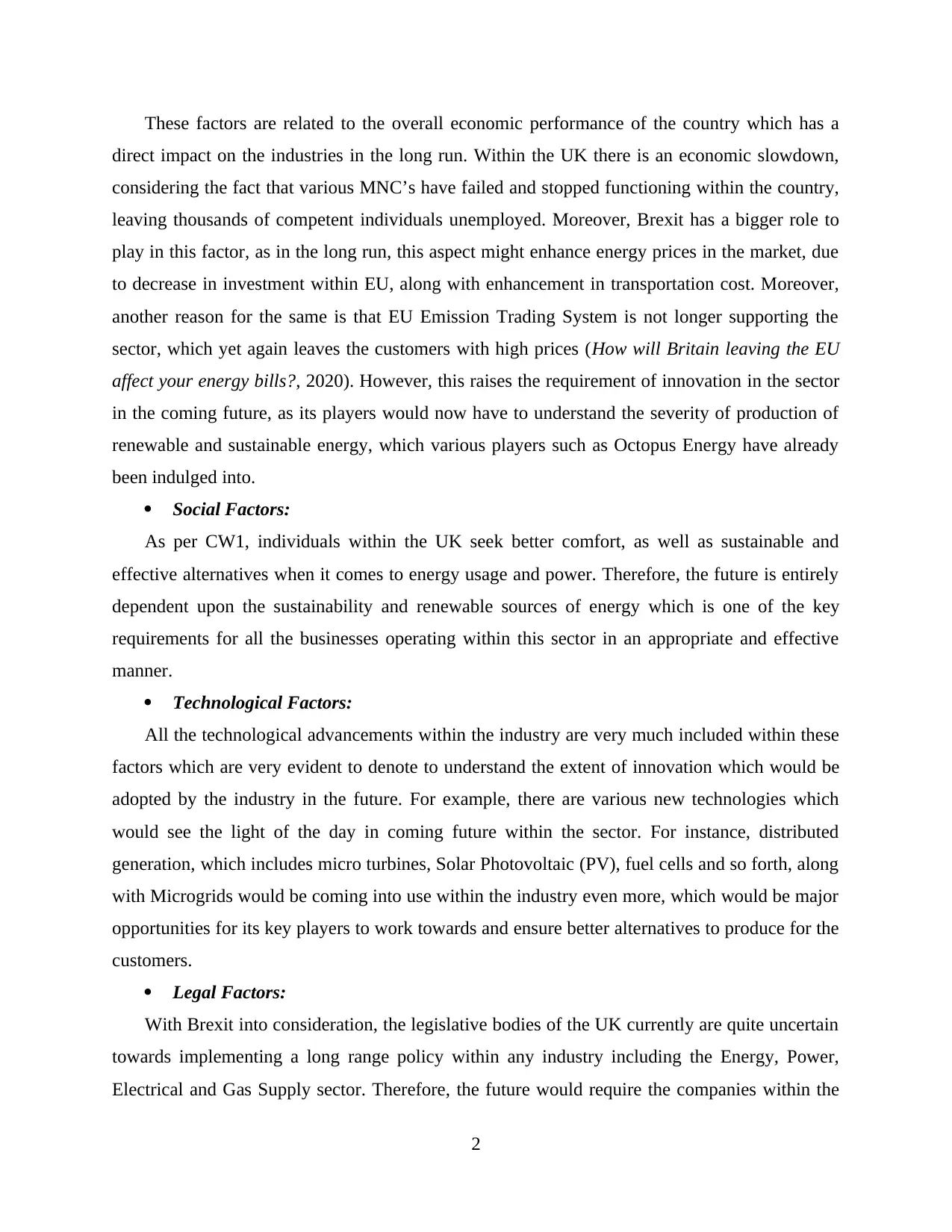
These factors are related to the overall economic performance of the country which has a
direct impact on the industries in the long run. Within the UK there is an economic slowdown,
considering the fact that various MNC’s have failed and stopped functioning within the country,
leaving thousands of competent individuals unemployed. Moreover, Brexit has a bigger role to
play in this factor, as in the long run, this aspect might enhance energy prices in the market, due
to decrease in investment within EU, along with enhancement in transportation cost. Moreover,
another reason for the same is that EU Emission Trading System is not longer supporting the
sector, which yet again leaves the customers with high prices (How will Britain leaving the EU
affect your energy bills?, 2020). However, this raises the requirement of innovation in the sector
in the coming future, as its players would now have to understand the severity of production of
renewable and sustainable energy, which various players such as Octopus Energy have already
been indulged into.
Social Factors:
As per CW1, individuals within the UK seek better comfort, as well as sustainable and
effective alternatives when it comes to energy usage and power. Therefore, the future is entirely
dependent upon the sustainability and renewable sources of energy which is one of the key
requirements for all the businesses operating within this sector in an appropriate and effective
manner.
Technological Factors:
All the technological advancements within the industry are very much included within these
factors which are very evident to denote to understand the extent of innovation which would be
adopted by the industry in the future. For example, there are various new technologies which
would see the light of the day in coming future within the sector. For instance, distributed
generation, which includes micro turbines, Solar Photovoltaic (PV), fuel cells and so forth, along
with Microgrids would be coming into use within the industry even more, which would be major
opportunities for its key players to work towards and ensure better alternatives to produce for the
customers.
Legal Factors:
With Brexit into consideration, the legislative bodies of the UK currently are quite uncertain
towards implementing a long range policy within any industry including the Energy, Power,
Electrical and Gas Supply sector. Therefore, the future would require the companies within the
2
direct impact on the industries in the long run. Within the UK there is an economic slowdown,
considering the fact that various MNC’s have failed and stopped functioning within the country,
leaving thousands of competent individuals unemployed. Moreover, Brexit has a bigger role to
play in this factor, as in the long run, this aspect might enhance energy prices in the market, due
to decrease in investment within EU, along with enhancement in transportation cost. Moreover,
another reason for the same is that EU Emission Trading System is not longer supporting the
sector, which yet again leaves the customers with high prices (How will Britain leaving the EU
affect your energy bills?, 2020). However, this raises the requirement of innovation in the sector
in the coming future, as its players would now have to understand the severity of production of
renewable and sustainable energy, which various players such as Octopus Energy have already
been indulged into.
Social Factors:
As per CW1, individuals within the UK seek better comfort, as well as sustainable and
effective alternatives when it comes to energy usage and power. Therefore, the future is entirely
dependent upon the sustainability and renewable sources of energy which is one of the key
requirements for all the businesses operating within this sector in an appropriate and effective
manner.
Technological Factors:
All the technological advancements within the industry are very much included within these
factors which are very evident to denote to understand the extent of innovation which would be
adopted by the industry in the future. For example, there are various new technologies which
would see the light of the day in coming future within the sector. For instance, distributed
generation, which includes micro turbines, Solar Photovoltaic (PV), fuel cells and so forth, along
with Microgrids would be coming into use within the industry even more, which would be major
opportunities for its key players to work towards and ensure better alternatives to produce for the
customers.
Legal Factors:
With Brexit into consideration, the legislative bodies of the UK currently are quite uncertain
towards implementing a long range policy within any industry including the Energy, Power,
Electrical and Gas Supply sector. Therefore, the future would require the companies within the
2
Paraphrase This Document
Need a fresh take? Get an instant paraphrase of this document with our AI Paraphraser
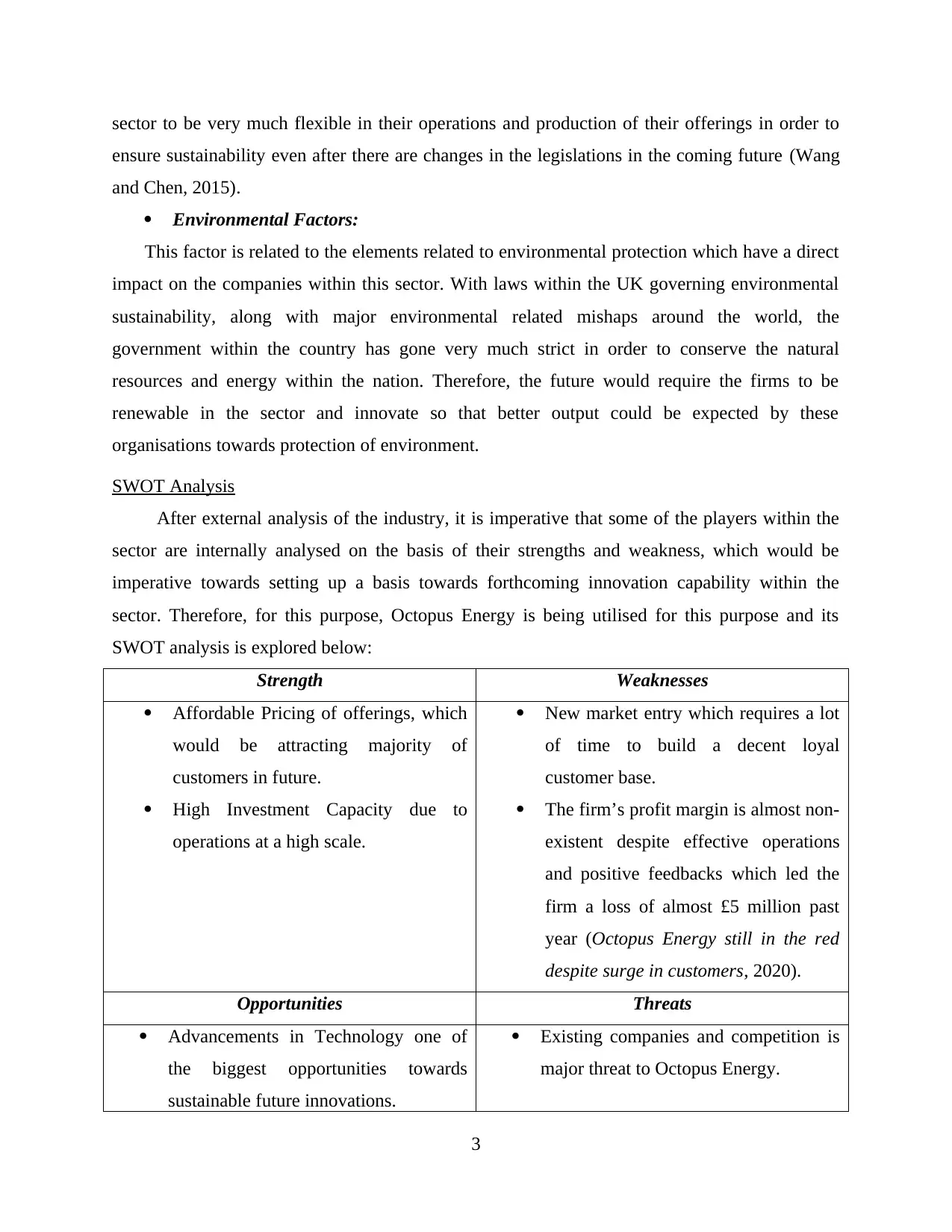
sector to be very much flexible in their operations and production of their offerings in order to
ensure sustainability even after there are changes in the legislations in the coming future (Wang
and Chen, 2015).
Environmental Factors:
This factor is related to the elements related to environmental protection which have a direct
impact on the companies within this sector. With laws within the UK governing environmental
sustainability, along with major environmental related mishaps around the world, the
government within the country has gone very much strict in order to conserve the natural
resources and energy within the nation. Therefore, the future would require the firms to be
renewable in the sector and innovate so that better output could be expected by these
organisations towards protection of environment.
SWOT Analysis
After external analysis of the industry, it is imperative that some of the players within the
sector are internally analysed on the basis of their strengths and weakness, which would be
imperative towards setting up a basis towards forthcoming innovation capability within the
sector. Therefore, for this purpose, Octopus Energy is being utilised for this purpose and its
SWOT analysis is explored below:
Strength Weaknesses
Affordable Pricing of offerings, which
would be attracting majority of
customers in future.
High Investment Capacity due to
operations at a high scale.
New market entry which requires a lot
of time to build a decent loyal
customer base.
The firm’s profit margin is almost non-
existent despite effective operations
and positive feedbacks which led the
firm a loss of almost £5 million past
year (Octopus Energy still in the red
despite surge in customers, 2020).
Opportunities Threats
Advancements in Technology one of
the biggest opportunities towards
sustainable future innovations.
Existing companies and competition is
major threat to Octopus Energy.
3
ensure sustainability even after there are changes in the legislations in the coming future (Wang
and Chen, 2015).
Environmental Factors:
This factor is related to the elements related to environmental protection which have a direct
impact on the companies within this sector. With laws within the UK governing environmental
sustainability, along with major environmental related mishaps around the world, the
government within the country has gone very much strict in order to conserve the natural
resources and energy within the nation. Therefore, the future would require the firms to be
renewable in the sector and innovate so that better output could be expected by these
organisations towards protection of environment.
SWOT Analysis
After external analysis of the industry, it is imperative that some of the players within the
sector are internally analysed on the basis of their strengths and weakness, which would be
imperative towards setting up a basis towards forthcoming innovation capability within the
sector. Therefore, for this purpose, Octopus Energy is being utilised for this purpose and its
SWOT analysis is explored below:
Strength Weaknesses
Affordable Pricing of offerings, which
would be attracting majority of
customers in future.
High Investment Capacity due to
operations at a high scale.
New market entry which requires a lot
of time to build a decent loyal
customer base.
The firm’s profit margin is almost non-
existent despite effective operations
and positive feedbacks which led the
firm a loss of almost £5 million past
year (Octopus Energy still in the red
despite surge in customers, 2020).
Opportunities Threats
Advancements in Technology one of
the biggest opportunities towards
sustainable future innovations.
Existing companies and competition is
major threat to Octopus Energy.
3
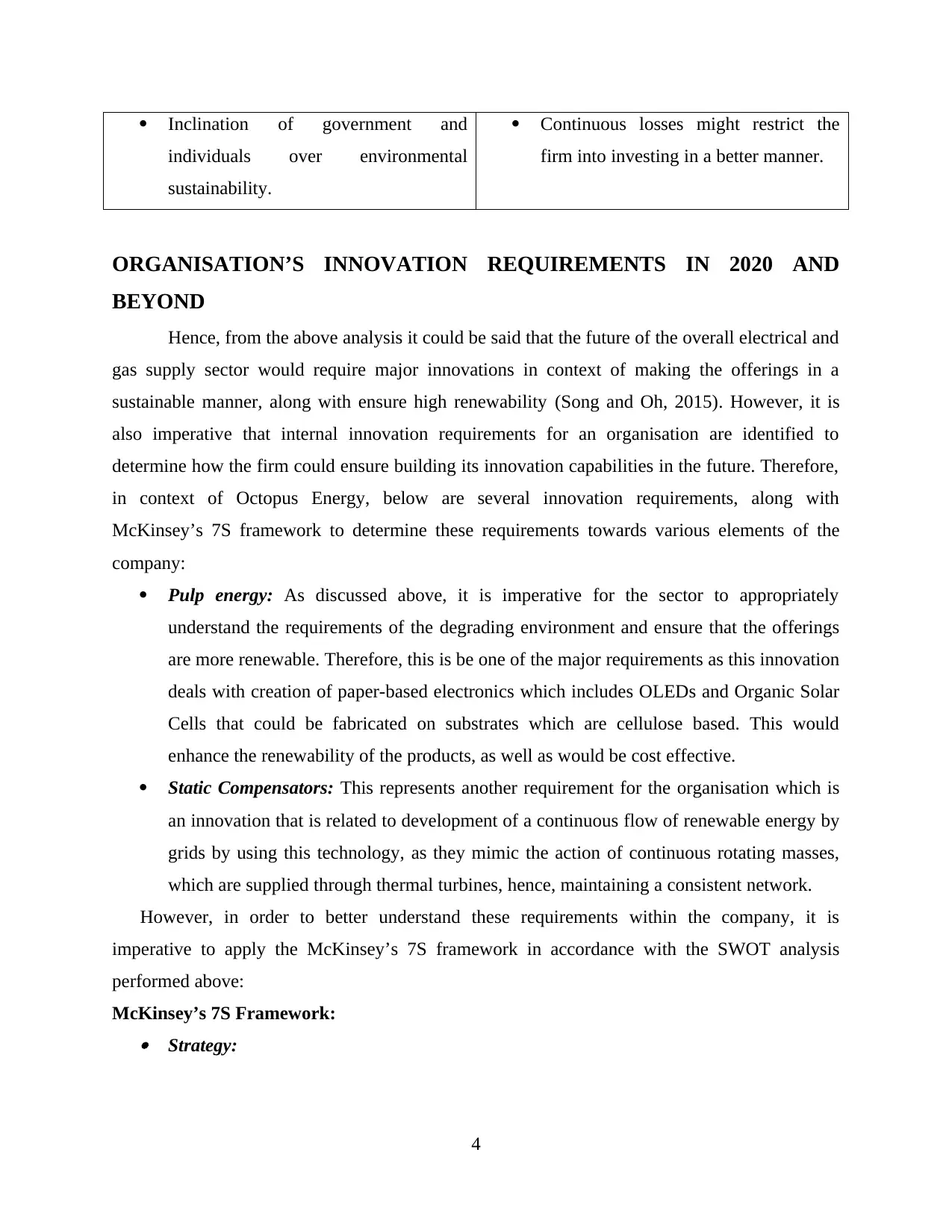
Inclination of government and
individuals over environmental
sustainability.
Continuous losses might restrict the
firm into investing in a better manner.
ORGANISATION’S INNOVATION REQUIREMENTS IN 2020 AND
BEYOND
Hence, from the above analysis it could be said that the future of the overall electrical and
gas supply sector would require major innovations in context of making the offerings in a
sustainable manner, along with ensure high renewability (Song and Oh, 2015). However, it is
also imperative that internal innovation requirements for an organisation are identified to
determine how the firm could ensure building its innovation capabilities in the future. Therefore,
in context of Octopus Energy, below are several innovation requirements, along with
McKinsey’s 7S framework to determine these requirements towards various elements of the
company:
Pulp energy: As discussed above, it is imperative for the sector to appropriately
understand the requirements of the degrading environment and ensure that the offerings
are more renewable. Therefore, this is be one of the major requirements as this innovation
deals with creation of paper-based electronics which includes OLEDs and Organic Solar
Cells that could be fabricated on substrates which are cellulose based. This would
enhance the renewability of the products, as well as would be cost effective.
Static Compensators: This represents another requirement for the organisation which is
an innovation that is related to development of a continuous flow of renewable energy by
grids by using this technology, as they mimic the action of continuous rotating masses,
which are supplied through thermal turbines, hence, maintaining a consistent network.
However, in order to better understand these requirements within the company, it is
imperative to apply the McKinsey’s 7S framework in accordance with the SWOT analysis
performed above:
McKinsey’s 7S Framework: Strategy:
4
individuals over environmental
sustainability.
Continuous losses might restrict the
firm into investing in a better manner.
ORGANISATION’S INNOVATION REQUIREMENTS IN 2020 AND
BEYOND
Hence, from the above analysis it could be said that the future of the overall electrical and
gas supply sector would require major innovations in context of making the offerings in a
sustainable manner, along with ensure high renewability (Song and Oh, 2015). However, it is
also imperative that internal innovation requirements for an organisation are identified to
determine how the firm could ensure building its innovation capabilities in the future. Therefore,
in context of Octopus Energy, below are several innovation requirements, along with
McKinsey’s 7S framework to determine these requirements towards various elements of the
company:
Pulp energy: As discussed above, it is imperative for the sector to appropriately
understand the requirements of the degrading environment and ensure that the offerings
are more renewable. Therefore, this is be one of the major requirements as this innovation
deals with creation of paper-based electronics which includes OLEDs and Organic Solar
Cells that could be fabricated on substrates which are cellulose based. This would
enhance the renewability of the products, as well as would be cost effective.
Static Compensators: This represents another requirement for the organisation which is
an innovation that is related to development of a continuous flow of renewable energy by
grids by using this technology, as they mimic the action of continuous rotating masses,
which are supplied through thermal turbines, hence, maintaining a consistent network.
However, in order to better understand these requirements within the company, it is
imperative to apply the McKinsey’s 7S framework in accordance with the SWOT analysis
performed above:
McKinsey’s 7S Framework: Strategy:
4
⊘ This is a preview!⊘
Do you want full access?
Subscribe today to unlock all pages.

Trusted by 1+ million students worldwide
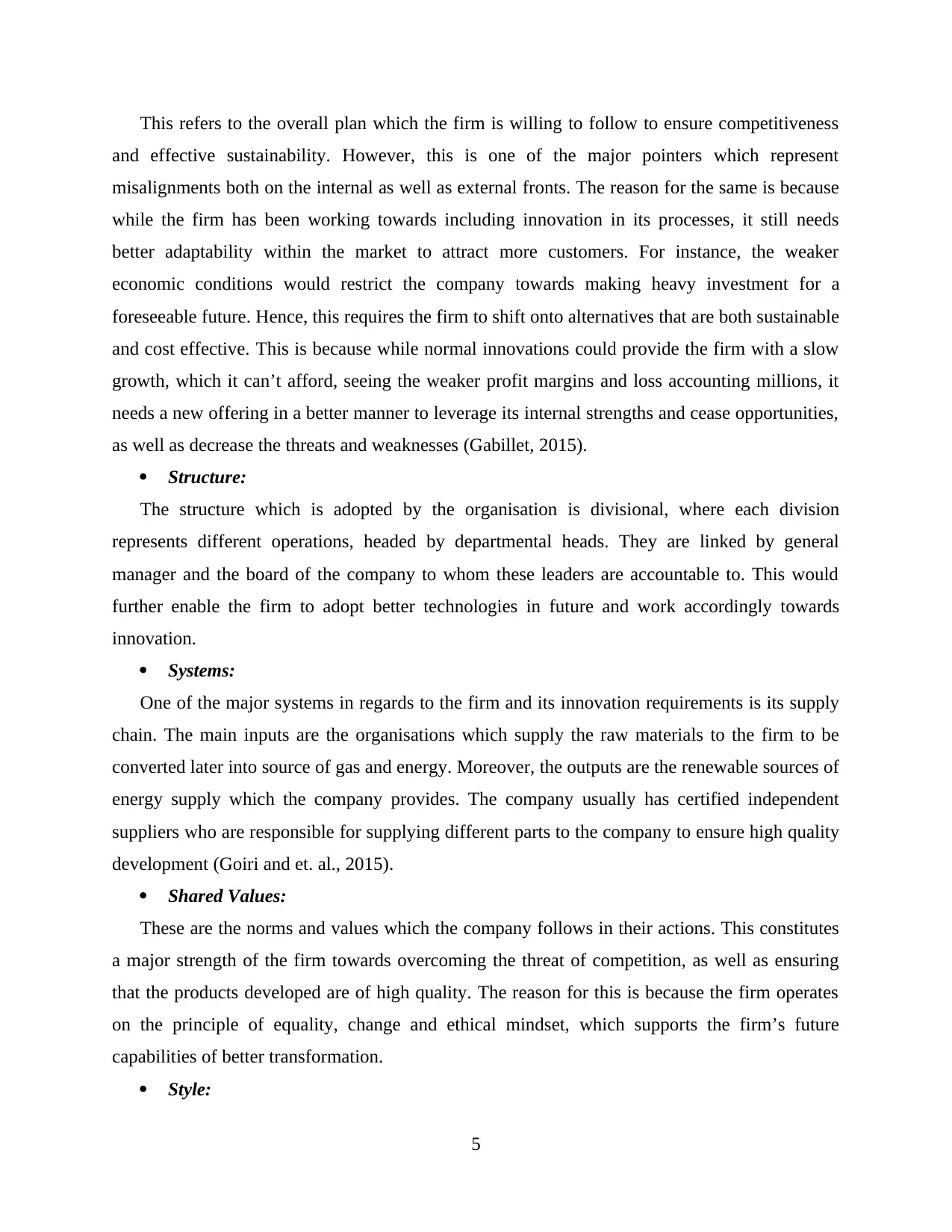
This refers to the overall plan which the firm is willing to follow to ensure competitiveness
and effective sustainability. However, this is one of the major pointers which represent
misalignments both on the internal as well as external fronts. The reason for the same is because
while the firm has been working towards including innovation in its processes, it still needs
better adaptability within the market to attract more customers. For instance, the weaker
economic conditions would restrict the company towards making heavy investment for a
foreseeable future. Hence, this requires the firm to shift onto alternatives that are both sustainable
and cost effective. This is because while normal innovations could provide the firm with a slow
growth, which it can’t afford, seeing the weaker profit margins and loss accounting millions, it
needs a new offering in a better manner to leverage its internal strengths and cease opportunities,
as well as decrease the threats and weaknesses (Gabillet, 2015).
Structure:
The structure which is adopted by the organisation is divisional, where each division
represents different operations, headed by departmental heads. They are linked by general
manager and the board of the company to whom these leaders are accountable to. This would
further enable the firm to adopt better technologies in future and work accordingly towards
innovation.
Systems:
One of the major systems in regards to the firm and its innovation requirements is its supply
chain. The main inputs are the organisations which supply the raw materials to the firm to be
converted later into source of gas and energy. Moreover, the outputs are the renewable sources of
energy supply which the company provides. The company usually has certified independent
suppliers who are responsible for supplying different parts to the company to ensure high quality
development (Goiri and et. al., 2015).
Shared Values:
These are the norms and values which the company follows in their actions. This constitutes
a major strength of the firm towards overcoming the threat of competition, as well as ensuring
that the products developed are of high quality. The reason for this is because the firm operates
on the principle of equality, change and ethical mindset, which supports the firm’s future
capabilities of better transformation.
Style:
5
and effective sustainability. However, this is one of the major pointers which represent
misalignments both on the internal as well as external fronts. The reason for the same is because
while the firm has been working towards including innovation in its processes, it still needs
better adaptability within the market to attract more customers. For instance, the weaker
economic conditions would restrict the company towards making heavy investment for a
foreseeable future. Hence, this requires the firm to shift onto alternatives that are both sustainable
and cost effective. This is because while normal innovations could provide the firm with a slow
growth, which it can’t afford, seeing the weaker profit margins and loss accounting millions, it
needs a new offering in a better manner to leverage its internal strengths and cease opportunities,
as well as decrease the threats and weaknesses (Gabillet, 2015).
Structure:
The structure which is adopted by the organisation is divisional, where each division
represents different operations, headed by departmental heads. They are linked by general
manager and the board of the company to whom these leaders are accountable to. This would
further enable the firm to adopt better technologies in future and work accordingly towards
innovation.
Systems:
One of the major systems in regards to the firm and its innovation requirements is its supply
chain. The main inputs are the organisations which supply the raw materials to the firm to be
converted later into source of gas and energy. Moreover, the outputs are the renewable sources of
energy supply which the company provides. The company usually has certified independent
suppliers who are responsible for supplying different parts to the company to ensure high quality
development (Goiri and et. al., 2015).
Shared Values:
These are the norms and values which the company follows in their actions. This constitutes
a major strength of the firm towards overcoming the threat of competition, as well as ensuring
that the products developed are of high quality. The reason for this is because the firm operates
on the principle of equality, change and ethical mindset, which supports the firm’s future
capabilities of better transformation.
Style:
5
Paraphrase This Document
Need a fresh take? Get an instant paraphrase of this document with our AI Paraphraser
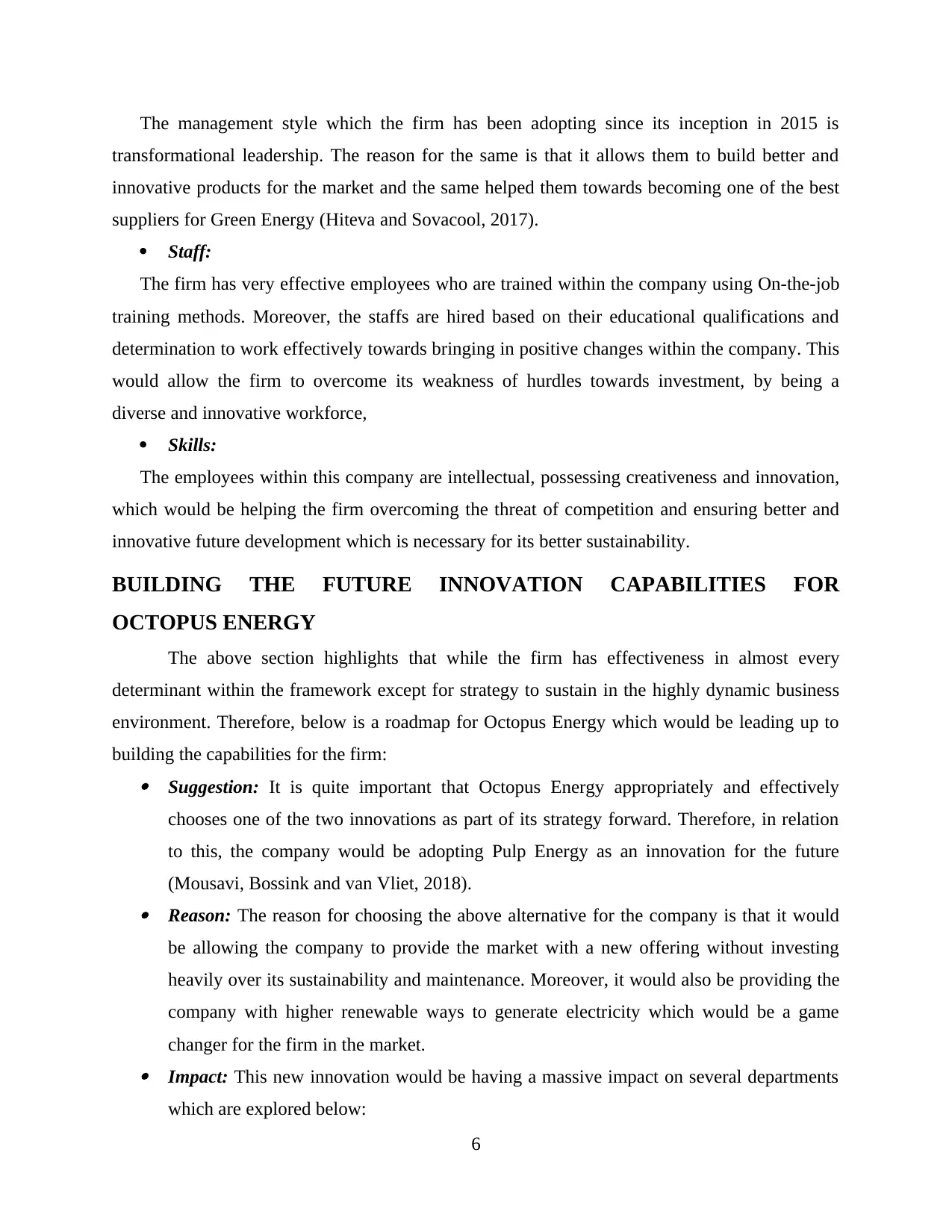
The management style which the firm has been adopting since its inception in 2015 is
transformational leadership. The reason for the same is that it allows them to build better and
innovative products for the market and the same helped them towards becoming one of the best
suppliers for Green Energy (Hiteva and Sovacool, 2017).
Staff:
The firm has very effective employees who are trained within the company using On-the-job
training methods. Moreover, the staffs are hired based on their educational qualifications and
determination to work effectively towards bringing in positive changes within the company. This
would allow the firm to overcome its weakness of hurdles towards investment, by being a
diverse and innovative workforce,
Skills:
The employees within this company are intellectual, possessing creativeness and innovation,
which would be helping the firm overcoming the threat of competition and ensuring better and
innovative future development which is necessary for its better sustainability.
BUILDING THE FUTURE INNOVATION CAPABILITIES FOR
OCTOPUS ENERGY
The above section highlights that while the firm has effectiveness in almost every
determinant within the framework except for strategy to sustain in the highly dynamic business
environment. Therefore, below is a roadmap for Octopus Energy which would be leading up to
building the capabilities for the firm: Suggestion: It is quite important that Octopus Energy appropriately and effectively
chooses one of the two innovations as part of its strategy forward. Therefore, in relation
to this, the company would be adopting Pulp Energy as an innovation for the future
(Mousavi, Bossink and van Vliet, 2018). Reason: The reason for choosing the above alternative for the company is that it would
be allowing the company to provide the market with a new offering without investing
heavily over its sustainability and maintenance. Moreover, it would also be providing the
company with higher renewable ways to generate electricity which would be a game
changer for the firm in the market. Impact: This new innovation would be having a massive impact on several departments
which are explored below:
6
transformational leadership. The reason for the same is that it allows them to build better and
innovative products for the market and the same helped them towards becoming one of the best
suppliers for Green Energy (Hiteva and Sovacool, 2017).
Staff:
The firm has very effective employees who are trained within the company using On-the-job
training methods. Moreover, the staffs are hired based on their educational qualifications and
determination to work effectively towards bringing in positive changes within the company. This
would allow the firm to overcome its weakness of hurdles towards investment, by being a
diverse and innovative workforce,
Skills:
The employees within this company are intellectual, possessing creativeness and innovation,
which would be helping the firm overcoming the threat of competition and ensuring better and
innovative future development which is necessary for its better sustainability.
BUILDING THE FUTURE INNOVATION CAPABILITIES FOR
OCTOPUS ENERGY
The above section highlights that while the firm has effectiveness in almost every
determinant within the framework except for strategy to sustain in the highly dynamic business
environment. Therefore, below is a roadmap for Octopus Energy which would be leading up to
building the capabilities for the firm: Suggestion: It is quite important that Octopus Energy appropriately and effectively
chooses one of the two innovations as part of its strategy forward. Therefore, in relation
to this, the company would be adopting Pulp Energy as an innovation for the future
(Mousavi, Bossink and van Vliet, 2018). Reason: The reason for choosing the above alternative for the company is that it would
be allowing the company to provide the market with a new offering without investing
heavily over its sustainability and maintenance. Moreover, it would also be providing the
company with higher renewable ways to generate electricity which would be a game
changer for the firm in the market. Impact: This new innovation would be having a massive impact on several departments
which are explored below:
6
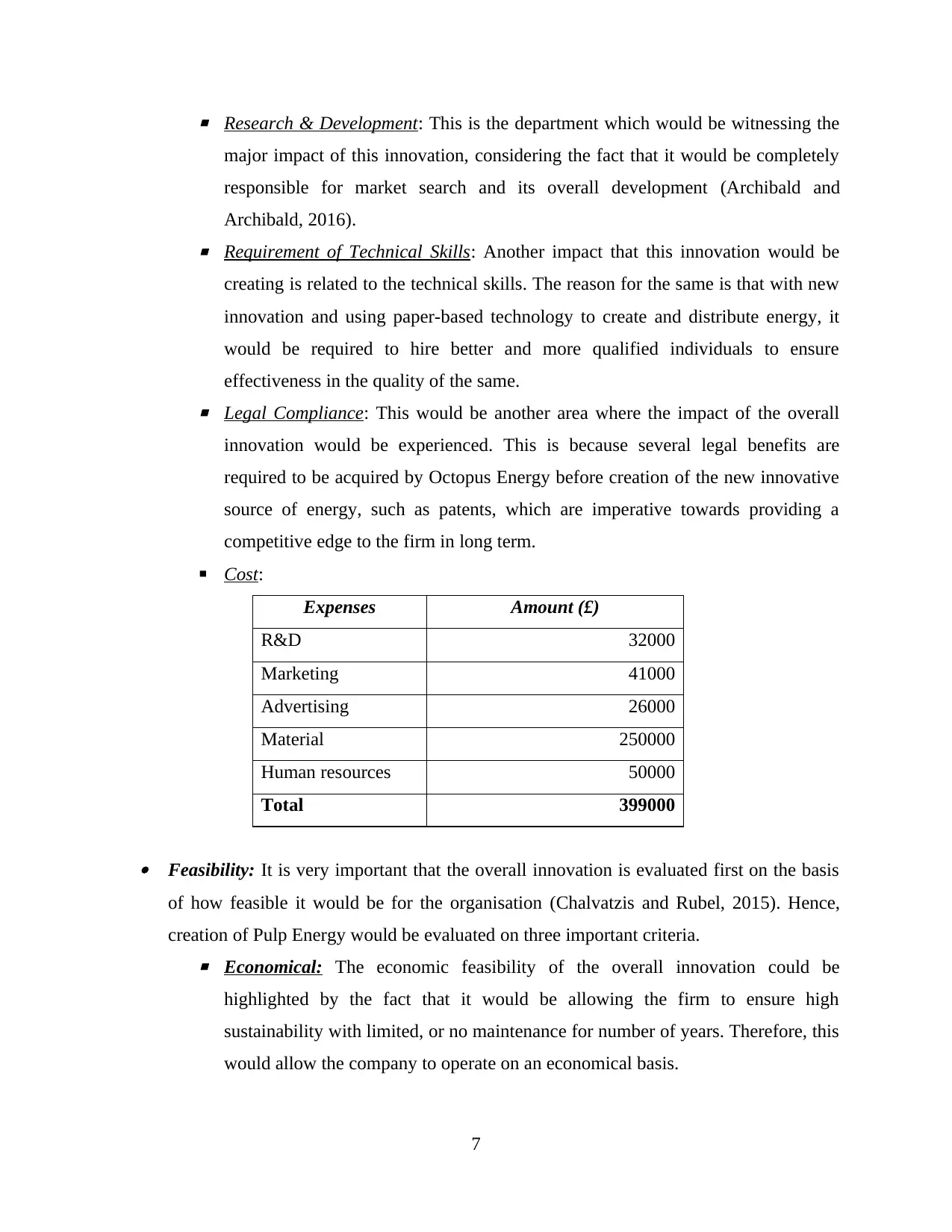
▪ Research & Development: This is the department which would be witnessing the
major impact of this innovation, considering the fact that it would be completely
responsible for market search and its overall development (Archibald and
Archibald, 2016).
▪ Requirement of Technical Skills: Another impact that this innovation would be
creating is related to the technical skills. The reason for the same is that with new
innovation and using paper-based technology to create and distribute energy, it
would be required to hire better and more qualified individuals to ensure
effectiveness in the quality of the same.
▪ Legal Compliance: This would be another area where the impact of the overall
innovation would be experienced. This is because several legal benefits are
required to be acquired by Octopus Energy before creation of the new innovative
source of energy, such as patents, which are imperative towards providing a
competitive edge to the firm in long term.
▪ Cost:
Expenses Amount (£)
R&D 32000
Marketing 41000
Advertising 26000
Material 250000
Human resources 50000
Total 399000
Feasibility: It is very important that the overall innovation is evaluated first on the basis
of how feasible it would be for the organisation (Chalvatzis and Rubel, 2015). Hence,
creation of Pulp Energy would be evaluated on three important criteria.
▪ Economical: The economic feasibility of the overall innovation could be
highlighted by the fact that it would be allowing the firm to ensure high
sustainability with limited, or no maintenance for number of years. Therefore, this
would allow the company to operate on an economical basis.
7
major impact of this innovation, considering the fact that it would be completely
responsible for market search and its overall development (Archibald and
Archibald, 2016).
▪ Requirement of Technical Skills: Another impact that this innovation would be
creating is related to the technical skills. The reason for the same is that with new
innovation and using paper-based technology to create and distribute energy, it
would be required to hire better and more qualified individuals to ensure
effectiveness in the quality of the same.
▪ Legal Compliance: This would be another area where the impact of the overall
innovation would be experienced. This is because several legal benefits are
required to be acquired by Octopus Energy before creation of the new innovative
source of energy, such as patents, which are imperative towards providing a
competitive edge to the firm in long term.
▪ Cost:
Expenses Amount (£)
R&D 32000
Marketing 41000
Advertising 26000
Material 250000
Human resources 50000
Total 399000
Feasibility: It is very important that the overall innovation is evaluated first on the basis
of how feasible it would be for the organisation (Chalvatzis and Rubel, 2015). Hence,
creation of Pulp Energy would be evaluated on three important criteria.
▪ Economical: The economic feasibility of the overall innovation could be
highlighted by the fact that it would be allowing the firm to ensure high
sustainability with limited, or no maintenance for number of years. Therefore, this
would allow the company to operate on an economical basis.
7
⊘ This is a preview!⊘
Do you want full access?
Subscribe today to unlock all pages.

Trusted by 1+ million students worldwide
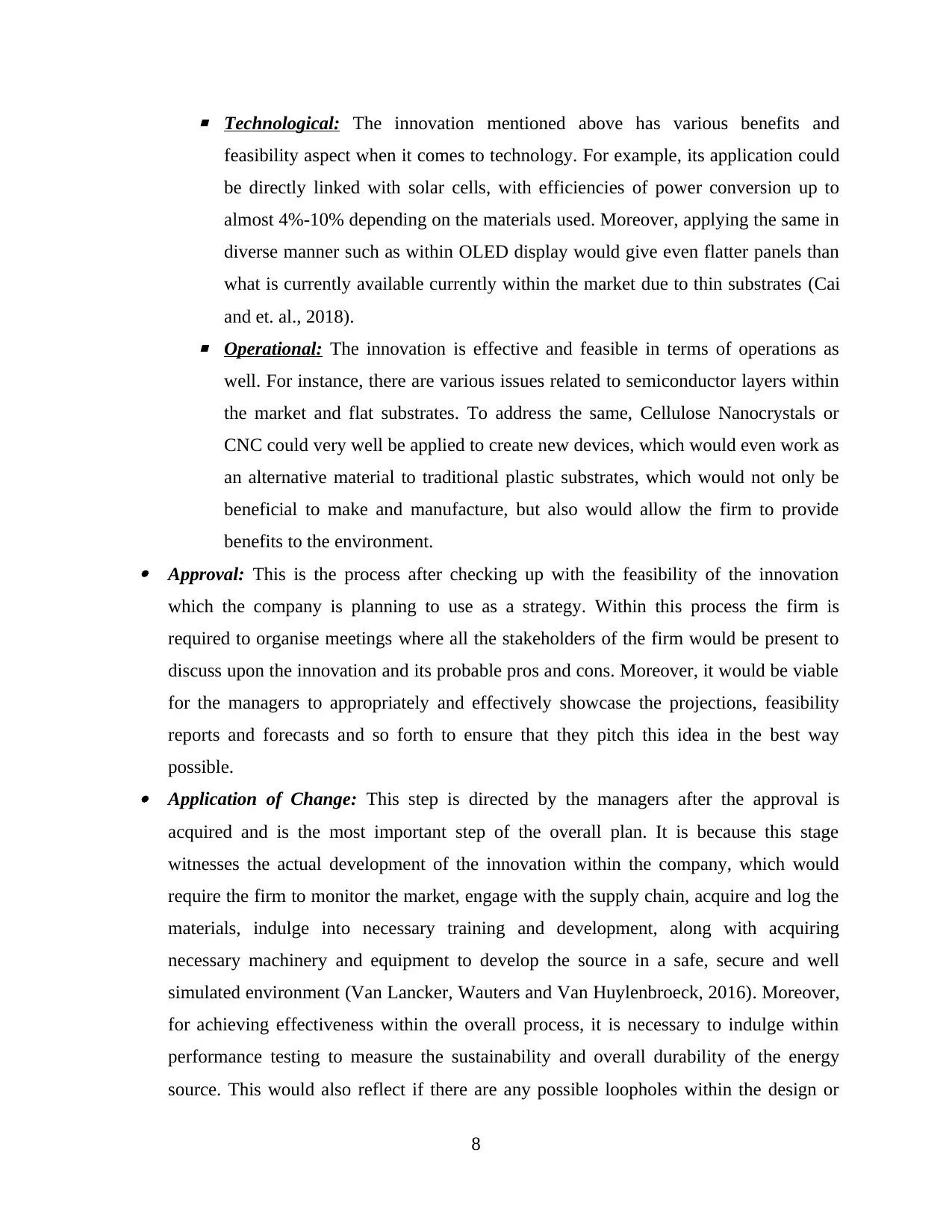
▪ Technological: The innovation mentioned above has various benefits and
feasibility aspect when it comes to technology. For example, its application could
be directly linked with solar cells, with efficiencies of power conversion up to
almost 4%-10% depending on the materials used. Moreover, applying the same in
diverse manner such as within OLED display would give even flatter panels than
what is currently available currently within the market due to thin substrates (Cai
and et. al., 2018).
▪ Operational: The innovation is effective and feasible in terms of operations as
well. For instance, there are various issues related to semiconductor layers within
the market and flat substrates. To address the same, Cellulose Nanocrystals or
CNC could very well be applied to create new devices, which would even work as
an alternative material to traditional plastic substrates, which would not only be
beneficial to make and manufacture, but also would allow the firm to provide
benefits to the environment. Approval: This is the process after checking up with the feasibility of the innovation
which the company is planning to use as a strategy. Within this process the firm is
required to organise meetings where all the stakeholders of the firm would be present to
discuss upon the innovation and its probable pros and cons. Moreover, it would be viable
for the managers to appropriately and effectively showcase the projections, feasibility
reports and forecasts and so forth to ensure that they pitch this idea in the best way
possible. Application of Change: This step is directed by the managers after the approval is
acquired and is the most important step of the overall plan. It is because this stage
witnesses the actual development of the innovation within the company, which would
require the firm to monitor the market, engage with the supply chain, acquire and log the
materials, indulge into necessary training and development, along with acquiring
necessary machinery and equipment to develop the source in a safe, secure and well
simulated environment (Van Lancker, Wauters and Van Huylenbroeck, 2016). Moreover,
for achieving effectiveness within the overall process, it is necessary to indulge within
performance testing to measure the sustainability and overall durability of the energy
source. This would also reflect if there are any possible loopholes within the design or
8
feasibility aspect when it comes to technology. For example, its application could
be directly linked with solar cells, with efficiencies of power conversion up to
almost 4%-10% depending on the materials used. Moreover, applying the same in
diverse manner such as within OLED display would give even flatter panels than
what is currently available currently within the market due to thin substrates (Cai
and et. al., 2018).
▪ Operational: The innovation is effective and feasible in terms of operations as
well. For instance, there are various issues related to semiconductor layers within
the market and flat substrates. To address the same, Cellulose Nanocrystals or
CNC could very well be applied to create new devices, which would even work as
an alternative material to traditional plastic substrates, which would not only be
beneficial to make and manufacture, but also would allow the firm to provide
benefits to the environment. Approval: This is the process after checking up with the feasibility of the innovation
which the company is planning to use as a strategy. Within this process the firm is
required to organise meetings where all the stakeholders of the firm would be present to
discuss upon the innovation and its probable pros and cons. Moreover, it would be viable
for the managers to appropriately and effectively showcase the projections, feasibility
reports and forecasts and so forth to ensure that they pitch this idea in the best way
possible. Application of Change: This step is directed by the managers after the approval is
acquired and is the most important step of the overall plan. It is because this stage
witnesses the actual development of the innovation within the company, which would
require the firm to monitor the market, engage with the supply chain, acquire and log the
materials, indulge into necessary training and development, along with acquiring
necessary machinery and equipment to develop the source in a safe, secure and well
simulated environment (Van Lancker, Wauters and Van Huylenbroeck, 2016). Moreover,
for achieving effectiveness within the overall process, it is necessary to indulge within
performance testing to measure the sustainability and overall durability of the energy
source. This would also reflect if there are any possible loopholes within the design or
8
Paraphrase This Document
Need a fresh take? Get an instant paraphrase of this document with our AI Paraphraser
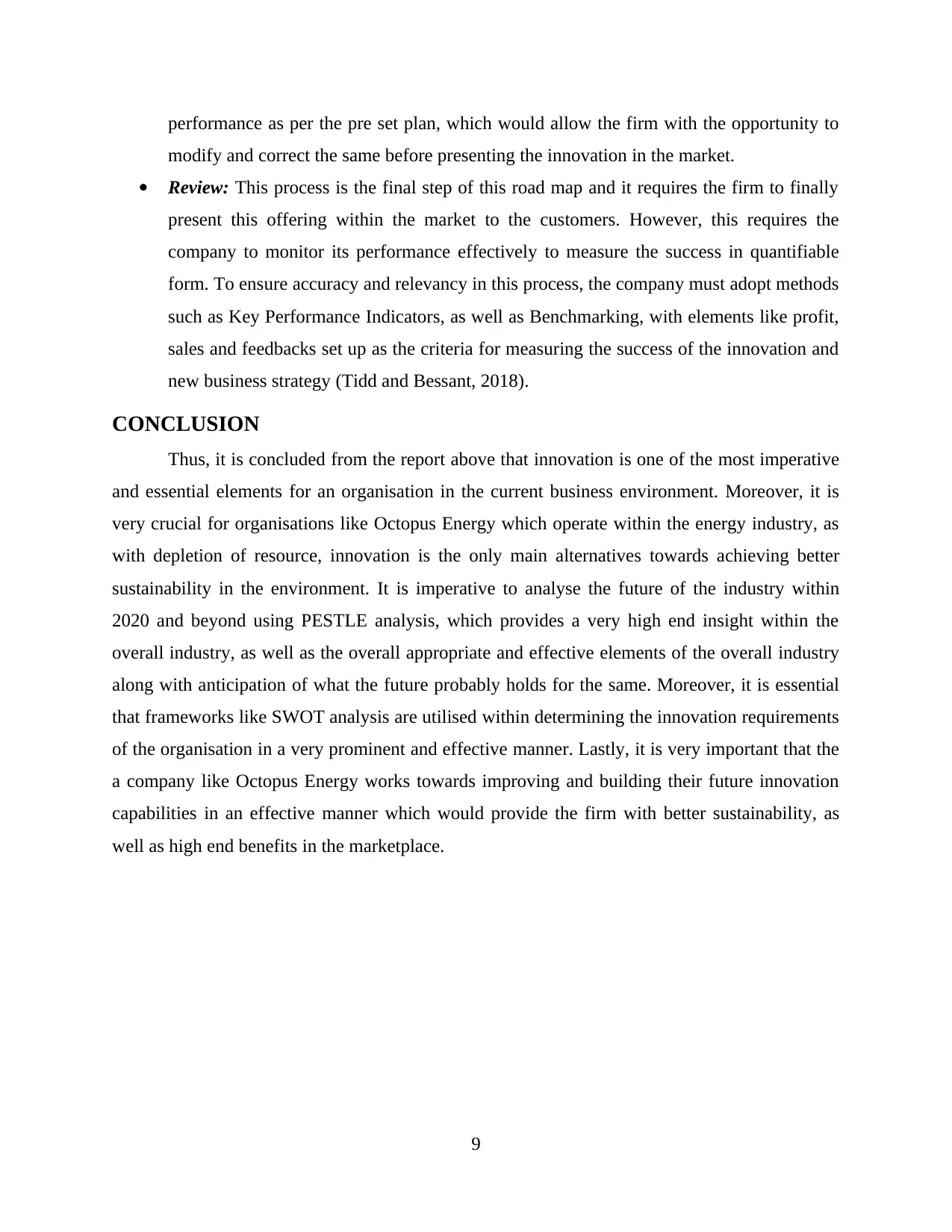
performance as per the pre set plan, which would allow the firm with the opportunity to
modify and correct the same before presenting the innovation in the market.
Review: This process is the final step of this road map and it requires the firm to finally
present this offering within the market to the customers. However, this requires the
company to monitor its performance effectively to measure the success in quantifiable
form. To ensure accuracy and relevancy in this process, the company must adopt methods
such as Key Performance Indicators, as well as Benchmarking, with elements like profit,
sales and feedbacks set up as the criteria for measuring the success of the innovation and
new business strategy (Tidd and Bessant, 2018).
CONCLUSION
Thus, it is concluded from the report above that innovation is one of the most imperative
and essential elements for an organisation in the current business environment. Moreover, it is
very crucial for organisations like Octopus Energy which operate within the energy industry, as
with depletion of resource, innovation is the only main alternatives towards achieving better
sustainability in the environment. It is imperative to analyse the future of the industry within
2020 and beyond using PESTLE analysis, which provides a very high end insight within the
overall industry, as well as the overall appropriate and effective elements of the overall industry
along with anticipation of what the future probably holds for the same. Moreover, it is essential
that frameworks like SWOT analysis are utilised within determining the innovation requirements
of the organisation in a very prominent and effective manner. Lastly, it is very important that the
a company like Octopus Energy works towards improving and building their future innovation
capabilities in an effective manner which would provide the firm with better sustainability, as
well as high end benefits in the marketplace.
9
modify and correct the same before presenting the innovation in the market.
Review: This process is the final step of this road map and it requires the firm to finally
present this offering within the market to the customers. However, this requires the
company to monitor its performance effectively to measure the success in quantifiable
form. To ensure accuracy and relevancy in this process, the company must adopt methods
such as Key Performance Indicators, as well as Benchmarking, with elements like profit,
sales and feedbacks set up as the criteria for measuring the success of the innovation and
new business strategy (Tidd and Bessant, 2018).
CONCLUSION
Thus, it is concluded from the report above that innovation is one of the most imperative
and essential elements for an organisation in the current business environment. Moreover, it is
very crucial for organisations like Octopus Energy which operate within the energy industry, as
with depletion of resource, innovation is the only main alternatives towards achieving better
sustainability in the environment. It is imperative to analyse the future of the industry within
2020 and beyond using PESTLE analysis, which provides a very high end insight within the
overall industry, as well as the overall appropriate and effective elements of the overall industry
along with anticipation of what the future probably holds for the same. Moreover, it is essential
that frameworks like SWOT analysis are utilised within determining the innovation requirements
of the organisation in a very prominent and effective manner. Lastly, it is very important that the
a company like Octopus Energy works towards improving and building their future innovation
capabilities in an effective manner which would provide the firm with better sustainability, as
well as high end benefits in the marketplace.
9
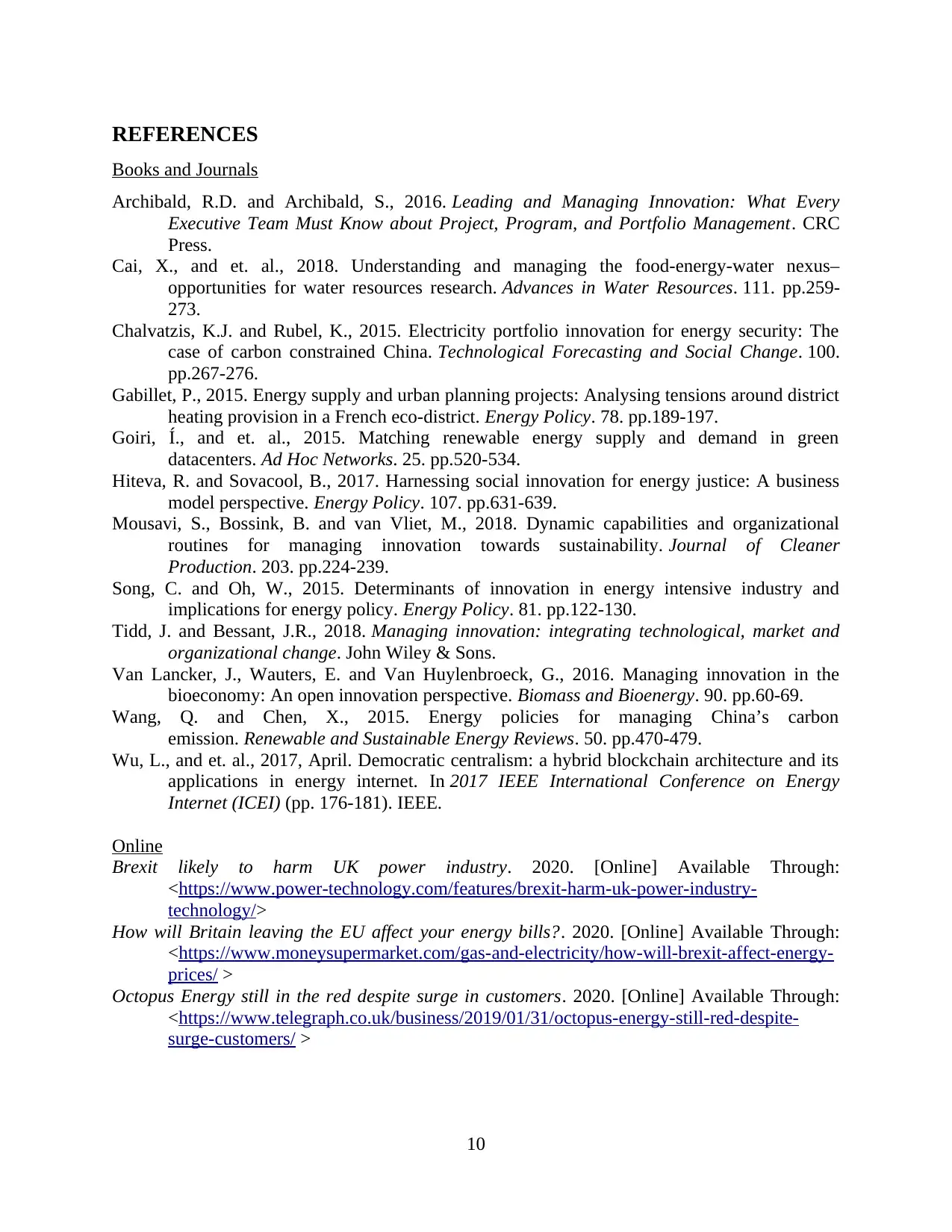
REFERENCES
Books and Journals
Archibald, R.D. and Archibald, S., 2016. Leading and Managing Innovation: What Every
Executive Team Must Know about Project, Program, and Portfolio Management. CRC
Press.
Cai, X., and et. al., 2018. Understanding and managing the food-energy-water nexus–
opportunities for water resources research. Advances in Water Resources. 111. pp.259-
273.
Chalvatzis, K.J. and Rubel, K., 2015. Electricity portfolio innovation for energy security: The
case of carbon constrained China. Technological Forecasting and Social Change. 100.
pp.267-276.
Gabillet, P., 2015. Energy supply and urban planning projects: Analysing tensions around district
heating provision in a French eco-district. Energy Policy. 78. pp.189-197.
Goiri, Í., and et. al., 2015. Matching renewable energy supply and demand in green
datacenters. Ad Hoc Networks. 25. pp.520-534.
Hiteva, R. and Sovacool, B., 2017. Harnessing social innovation for energy justice: A business
model perspective. Energy Policy. 107. pp.631-639.
Mousavi, S., Bossink, B. and van Vliet, M., 2018. Dynamic capabilities and organizational
routines for managing innovation towards sustainability. Journal of Cleaner
Production. 203. pp.224-239.
Song, C. and Oh, W., 2015. Determinants of innovation in energy intensive industry and
implications for energy policy. Energy Policy. 81. pp.122-130.
Tidd, J. and Bessant, J.R., 2018. Managing innovation: integrating technological, market and
organizational change. John Wiley & Sons.
Van Lancker, J., Wauters, E. and Van Huylenbroeck, G., 2016. Managing innovation in the
bioeconomy: An open innovation perspective. Biomass and Bioenergy. 90. pp.60-69.
Wang, Q. and Chen, X., 2015. Energy policies for managing China’s carbon
emission. Renewable and Sustainable Energy Reviews. 50. pp.470-479.
Wu, L., and et. al., 2017, April. Democratic centralism: a hybrid blockchain architecture and its
applications in energy internet. In 2017 IEEE International Conference on Energy
Internet (ICEI) (pp. 176-181). IEEE.
Online
Brexit likely to harm UK power industry. 2020. [Online] Available Through:
<https://www.power-technology.com/features/brexit-harm-uk-power-industry-
technology/>
How will Britain leaving the EU affect your energy bills?. 2020. [Online] Available Through:
<https://www.moneysupermarket.com/gas-and-electricity/how-will-brexit-affect-energy-
prices/ >
Octopus Energy still in the red despite surge in customers. 2020. [Online] Available Through:
<https://www.telegraph.co.uk/business/2019/01/31/octopus-energy-still-red-despite-
surge-customers/ >
10
Books and Journals
Archibald, R.D. and Archibald, S., 2016. Leading and Managing Innovation: What Every
Executive Team Must Know about Project, Program, and Portfolio Management. CRC
Press.
Cai, X., and et. al., 2018. Understanding and managing the food-energy-water nexus–
opportunities for water resources research. Advances in Water Resources. 111. pp.259-
273.
Chalvatzis, K.J. and Rubel, K., 2015. Electricity portfolio innovation for energy security: The
case of carbon constrained China. Technological Forecasting and Social Change. 100.
pp.267-276.
Gabillet, P., 2015. Energy supply and urban planning projects: Analysing tensions around district
heating provision in a French eco-district. Energy Policy. 78. pp.189-197.
Goiri, Í., and et. al., 2015. Matching renewable energy supply and demand in green
datacenters. Ad Hoc Networks. 25. pp.520-534.
Hiteva, R. and Sovacool, B., 2017. Harnessing social innovation for energy justice: A business
model perspective. Energy Policy. 107. pp.631-639.
Mousavi, S., Bossink, B. and van Vliet, M., 2018. Dynamic capabilities and organizational
routines for managing innovation towards sustainability. Journal of Cleaner
Production. 203. pp.224-239.
Song, C. and Oh, W., 2015. Determinants of innovation in energy intensive industry and
implications for energy policy. Energy Policy. 81. pp.122-130.
Tidd, J. and Bessant, J.R., 2018. Managing innovation: integrating technological, market and
organizational change. John Wiley & Sons.
Van Lancker, J., Wauters, E. and Van Huylenbroeck, G., 2016. Managing innovation in the
bioeconomy: An open innovation perspective. Biomass and Bioenergy. 90. pp.60-69.
Wang, Q. and Chen, X., 2015. Energy policies for managing China’s carbon
emission. Renewable and Sustainable Energy Reviews. 50. pp.470-479.
Wu, L., and et. al., 2017, April. Democratic centralism: a hybrid blockchain architecture and its
applications in energy internet. In 2017 IEEE International Conference on Energy
Internet (ICEI) (pp. 176-181). IEEE.
Online
Brexit likely to harm UK power industry. 2020. [Online] Available Through:
<https://www.power-technology.com/features/brexit-harm-uk-power-industry-
technology/>
How will Britain leaving the EU affect your energy bills?. 2020. [Online] Available Through:
<https://www.moneysupermarket.com/gas-and-electricity/how-will-brexit-affect-energy-
prices/ >
Octopus Energy still in the red despite surge in customers. 2020. [Online] Available Through:
<https://www.telegraph.co.uk/business/2019/01/31/octopus-energy-still-red-despite-
surge-customers/ >
10
⊘ This is a preview!⊘
Do you want full access?
Subscribe today to unlock all pages.

Trusted by 1+ million students worldwide
1 out of 12
Related Documents
Your All-in-One AI-Powered Toolkit for Academic Success.
+13062052269
info@desklib.com
Available 24*7 on WhatsApp / Email
![[object Object]](/_next/static/media/star-bottom.7253800d.svg)
Unlock your academic potential
Copyright © 2020–2025 A2Z Services. All Rights Reserved. Developed and managed by ZUCOL.




